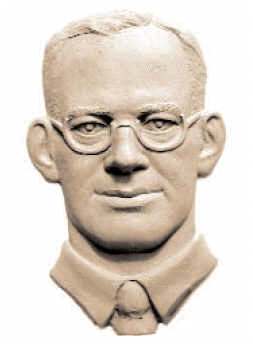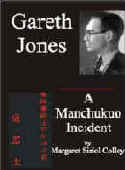Gareth Jones
[bas relief by Oleh Lesiuk]
HOME |
Stop Press |
Complete Soviet Articles & Background Information |
Précis of Gareth's
|
All Published Articles |
BOOKS
|
|
|
|
More Than Grain of Truth(2005) |
|
|
TOPICAL
'Are you Listening NYT?' U.N. Speech - Nov 2009 |
Gareth Recognised at Cambridge - Nov 2009 |
Reporter and the Genocide - Rome, March 2009 |
Order of Freedom Award -Nov 2008 |
Premiere of 'The Living' Documentary Kyiv - Nov 2008 |
Gareth Jones 'Famine' Diaries - Chicago 2008 |
Aberystwyth Memorial Plaque 2006 |
GENERAL
Scholarship Fund |
Site Map |
Links |
Legal Notices |
Sponsored Links |
Contact |
The Western Mail 23nd July, 1933Craftsmen of Wales A Poet in the Clogmaker's Shop of TanygroesWhy the Sycamore is the Sacred wood of the CraftBy GARETH JONESThe clogmaker is still a figure in Cardiganshire and in Pembroke-shire. He often carries on the tradition by which the cobbler’s shop is the university of the village. This is certainly true of the clog-maker’s shop at Tanygroes, seven miles north of Cardigan, where it is a pleasure to listen to Mr. David Thomas talking of his trade and traditions and to meet his son, Mr. T. 0. Thomas, a poet who has won nineteen chairs at eisteddfodau and one crown, and was second in the sonnet in the National Eisteddfod at Swansea. T. 0. Thomas, poet and clogmaker, sits on his bench, which itself is perhaps a century old. Welsh friends from the village gather round, and everyone has a story. Legends are revived, and Mr. David Thomas, the father, tells why the sycamore has become the sacred wood of the clogmaker: “When the Lord was travelling in Jerusalem, Zacchaeus, being a small man, climbed up a sycamore tree to see Him passing by. The Lord beheld him on the tree and told him to come down. He did so and became a follower, and ever since that day the sycamore tree has been consecrated for the making of clogs.” The KnivesT. 0. Thomas then took a piece of rough sycamore, and with his special tools rapidly brought it into the shape on which he would begin to carve it with the old hooked knife. There were four knives used in the process, the first to cut the block of wood into shape, the second to snake the “channel,” the third to “hollow,” and the fourth was the hooked knife, the “cyllell gam,” which is also used to make spoons. “These hooked knives were made by an old blacksmith in Maesllyn, Llandyssul,” explained Mr. David Thomas, “but he has died, and no one can make them to-day. It was a real art.” The knife which T. 0. Thomas used was forty years old, and his father has one over a hundred years old. The difficulty in making the knives lies in accomplishing a certain double twist essential for the carving of the clogs. Unbeatable Clog“Have the South Cardiganshire clogs any special characteristics?” I asked. They told me that the South Cardiganshire clog is quite different from the Lancashire clog, and it is impossible for the Lancashire clogmakers to make the same shape as the Cardiganshire men. The South Cardiganshire clog, it appears, is better for the foot than the Lancashire clog, which has no instep support. The Welsh clog is also different in the pattern of the uppers. In South Cardiganshire most people still wear clogs in the country, especially in the winter. The uppers are of leather and are attached by the clogmaker to the clogs, which in old Welsh were called “ffollaehau.” Such a clog, which usually lasts about a year, has also a narrow iron band on the sole having the shape of a horseshoe, and a smaller one on the heel. The iron is called a “rasyn.” All the clogs are made to order. Old Ifan BryngwynWhat stories of the old clogmakers David Thomas could tell. There was old Ifan Bryngwyn in the last century. He had no rival in the craft. He would be at his work when he would hear the cry of the foxhound. Nothing could then keep him. Hurling the clogs away in a clatter, he would rush out and away to the hunt. To illustrate the craftsman’s pride, Mr. Thomas told of how Ifan Bryngwyn once brought a new pair of clogs to the dainty wife of the innkeeper of the Ship Hotel. The wife’s sister, admiring them, was desirous of having clogs for herself from the famous master, but he turned to her and said: “No, for you I cannot make them, for your” feet are not shapely enough.” Another clogmaker was Ifan Cruddy, Penbank, Peninorfa, a learned man, who died more than 30 years ago and who owned the seat upon which the Tanygroes clog-makers now sit at their work. Better LeatherThe old clog-makers like Ifan Bryngwyn and Ifan Crudd had one advantage over the craftsmen of to day in that their leather was better. Mr. David Thomas laments the loss of the Welsh tanneries, and says: “The English leather-makers cannot make such good leather. The old Welsh leather was unbeatable. The greatest loss we South Cardiganshire clogmakers had was when Bateman, the currier, Llanarth, died. He made wonderful leather for the uppers of clogs. Another fine currier was Ehedydd Emlyn. Newcastle Emlyn, who was a poet. His widow still lives in Newcastle Emlyn.” The old Welsh tanning industry has died cut completely, and the South Cardiganshire clogmakers have tried leather from Lancashire, Yorkshire, Somerset, Bermondsey, and. other places, and yet they cannot beat the old Welsh curriers for working cow hide for clog-making. It was difficult to tear myself away from the clogmaker’s shop, from the stories and the memories. I had seen the. unity of culture and craftsmanship, of learning and of labour, which still remains one of the most cherished possessions of Wales. |
GARETH JONES (1905 -35) |




